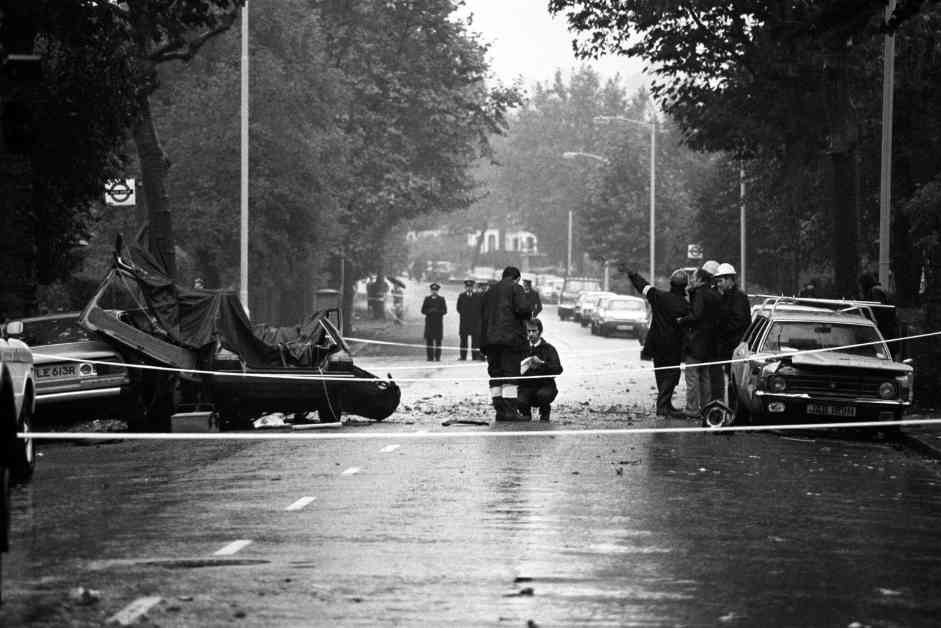The IRA’s 1981 London Attack: A Bloody Return to Violence
On a fateful Saturday morning in October 1981, Lieutenant-General Sir Steuart Pringle, the head of the Royal Marines, found himself at the center of a horrific attack that would change his life forever. Leaving his home in South Croxted Road, Dulwich, he never could have anticipated the devastation that awaited him. As he got into his red Volkswagen Passat with his beloved Labrador Bella in the back, a bomb planted by the Irish Republican Army (IRA) exploded, shattering his car and tearing his legs to shreds.
The aftermath of the explosion left a scene of chaos and destruction, with the car’s bonnet blown off and half of the engine catapulted away. Despite the severe injuries he sustained, Lieutenant-General Pringle displayed remarkable resilience and presence of mind. In a statement read out at the bombers’ trial, he recounted the harrowing experience of hearing the blast, feeling his legs being thrown to the side of the car, and realizing the extent of his injuries. Yet, in the midst of the chaos, his thoughts turned to his dog, Bella, ensuring her safety even as he grappled with his own pain.
The attack on Lieutenant-General Pringle was not an isolated incident but part of a series of violent acts carried out by the IRA in London during a tumultuous period known as the “Troubles.” The year 1981 was marked by the hunger strikes and the death of Bobby Sands, sparking protests against Margaret Thatcher’s government’s refusal to grant political status to IRA prisoners. Against this backdrop of heightened tensions, the IRA’s campaign of violence in London escalated, culminating in the bombing at Chelsea Barracks that claimed the lives of civilians and soldiers alike.
Amidst the backdrop of fear and uncertainty, Lieutenant-General Pringle’s resilience and determination stood as a testament to the indomitable spirit of those who faced the horrors of terrorism head-on. Despite the physical and psychological toll of the attack, he displayed remarkable courage and fortitude in the face of adversity. His unwavering commitment to duty and service exemplified the ethos of the Royal Marines, embodying the values of courage, discipline, and selflessness in the face of danger.
The Aftermath and Recovery
The aftermath of the bombing left Lieutenant-General Pringle with severe injuries that required extensive medical intervention. It took surgeons three hours to extricate him from the wreckage of his car and stabilize his condition, a testament to the severity of the blast and the extent of his injuries. Despite the grueling recovery process that lay ahead, Lieutenant-General Pringle remained resolute in his determination to overcome the challenges he faced and return to his duties at the Ministry of Defence.
As he navigated the arduous path to recovery, Lieutenant-General Pringle drew upon his experiences to support others facing similar challenges. His resilience and determination inspired wounded veterans of the Falklands War, offering them hope and encouragement in their own journeys of healing and rehabilitation. His advocacy for disabled individuals, both military and civilian, underscored his commitment to serving others and making a positive impact on society.
A Legacy of Service and Sacrifice
Lieutenant-General Sir Steuart Pringle’s legacy extends far beyond the events of that fateful day in 1981. His unwavering dedication to duty, his resilience in the face of adversity, and his commitment to serving others exemplify the values of courage, honor, and sacrifice that define the Royal Marines. Throughout his distinguished career, he embodied the ethos of service before self, demonstrating a profound sense of duty and responsibility to his country and fellow servicemen.
In the years following the attack, Lieutenant-General Pringle continued to make a lasting impact through his advocacy for disabled individuals and wounded veterans. His leadership and compassion inspired countless individuals to overcome their own challenges and strive for a better future. As chairman and chief executive of the Chatham Historic Dockyard Trust, he left a lasting legacy of service and dedication to preserving Britain’s maritime heritage.
In his passing in 2013, Lieutenant-General Sir Steuart Pringle left behind a legacy of courage, resilience, and selflessness that continues to inspire generations of servicemen and civilians alike. His unwavering commitment to duty, his compassion for others, and his indomitable spirit in the face of adversity serve as a testament to the values that define the Royal Marines and the enduring legacy of those who serve with honor and sacrifice.












